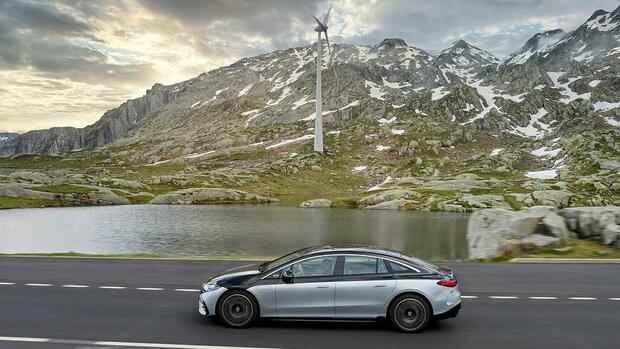Munich It was a signal of departure. A few days before he officially took office as CEO of Mercedes-Benz almost three years ago, Ola Källenius announced that he wanted to make the Stuttgart car manufacturer completely climate-neutral within 20 years. Now the Swede is setting an ambitious interim goal for his troops in his “Ambition 2039”. Specifically, the brand with the star is to reduce its carbon dioxide emissions per car by at least half compared to 2020 by the end of the decade.
Källenius announced this on Monday at Mercedes’ first digital ESG conference. The Dax group wants to achieve its new sustainability goal by electrifying its fleet, making greater use of renewable energies in production, better batteries and a comprehensive recycling concept.
By 2030, 70 percent of the energy requirements in production alone are to be covered by green sources. To this end, Mercedes wants to equip the roofs of its factories with solar systems and set up some wind turbines at its locations. In addition, the company plans to conclude more power purchase agreements and thus secure large quantities of alternative energy.
“The desire for individual mobility is growing all the time. Our job is to meet this need in a sustainable way,” explained Mercedes boss Källenius. “In order to make faster progress on climate protection, we need maximum commitment and more cooperation between politics, business and society as a whole.”
Top jobs of the day
Find the best jobs now and
be notified by email.
Mercedes production is also to become more climate-friendly
Mercedes wants to do this in advance. By the end of the decade, the group is aiming to only sell fully electric new cars. “Electric only”, everything under power, is the strategy of the Swabians.
In order to drastically reduce the CO2 emissions of its fleet not only when driving, but also those that arise in production, Mercedes swears by a new cell chemistry in its energy storage systems.
“The battery is the biggest lever for reducing CO2 emissions,” emphasizes the group. With the current electricity mix in the EU, more than half of the polluting carbon emissions over the life of a car would come from the supply chain and production. “By switching to CO2-neutral cell production, we have reduced emissions in the production of the entire battery pack by 20 percent,” emphasizes Mercedes Head of Development Markus Schäfer.
>> Read about this: On the way to the green solid-state battery – this is how batteries should get better
The engineer wants to noticeably increase the energy density of batteries with partner companies such as the battery specialist Sila Nano. “In fact, we will reach more than 800 watt hours per liter at the cell level by the middle of the decade,” announced Schäfer. For comparison: In 2020, the energy density of batteries in the automotive industry was 400 watt hours per liter on average, according to Fraunhofer ISI data. Mercedes would like to achieve this doubling of the energy density within a few years by using anodes with a much higher proportion of silicon than is usual today.
In addition to lithium-ion batteries, Mercedes intends to use lithium-iron phosphate batteries in its production vehicles in the future. Their advantage: their cathodes do not require any conflict resource, cobalt. Tesla is already installing corresponding batteries.
However, solid-state batteries, which do not use liquid electrolytes and are therefore far safer than all other battery technologies, are considered a real game changer in the industry. “We expect series production by 2028,” says Mercedes manager Schäfer.
Mixed climate balance
With the help of green steel and the use of renewable raw materials, the Mercedes luxury bodies are gradually becoming more ecological. The group already offers seat covers made from recycled PET bottles or cable ducts made from landfill waste. By 2030, the Stuttgart-based company wants to increase the proportion of such reused materials per vehicle to 40 percent. Mercedes is also building its own recycling factory in Kuppenheim in southern Germany.
Mercedes’ announcements sound promising. In the here and now, however, the climate balance of the Swabians is ambiguous. The share of purely electric models in total sales is still only 4.1 percent. Mercedes deliberately sells most of the Stromer in Europe. The group was recently able to reduce the emission of climate-damaging carbon dioxide in its fleet to 115 grams per kilometer and thus meets the legal requirements. The situation is different in China and the USA.
There, Mercedes missed the fleet specifications on its own. Mercedes was only able to meet its targets in China and the USA by acquiring pollution rights from third parties, such as pure electric car manufacturers such as Tesla. And the Swabians obviously don’t intend to change this practice quickly. In China, the company is only aiming to meet the requirements on its own in the medium term. This is “not very ambitious”, complains Ingo Speich, Head of Sustainability and Corporate Governance at Deka Investment.
More: “We have tailwind on the capital market” – Daimler ensnares investors with green bonds
